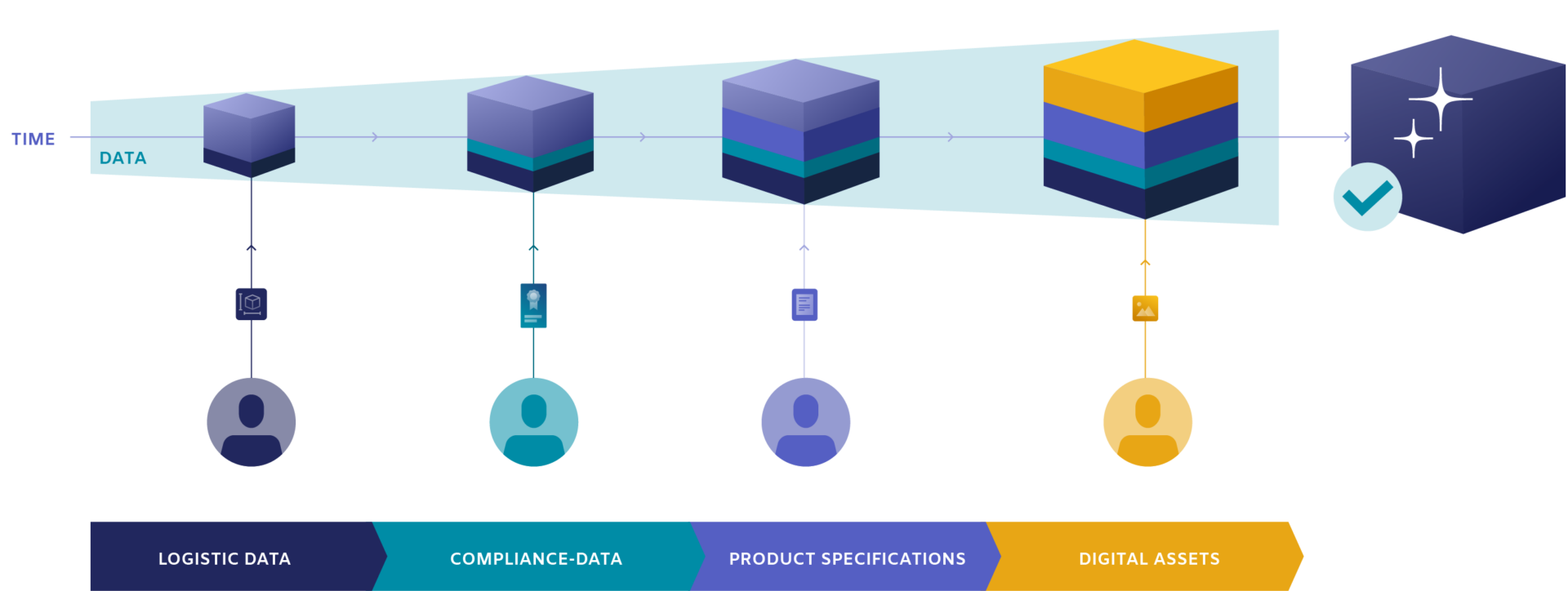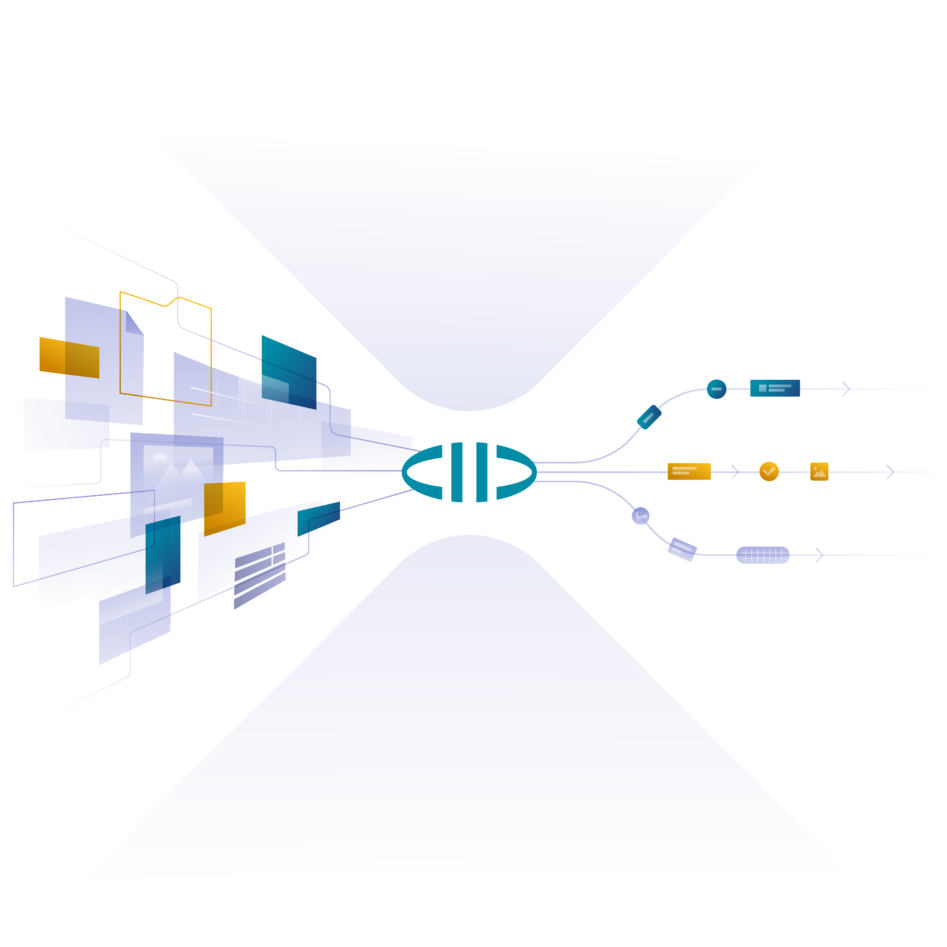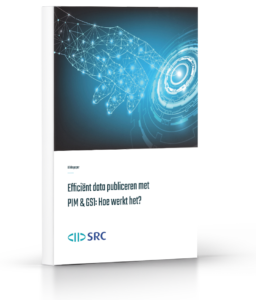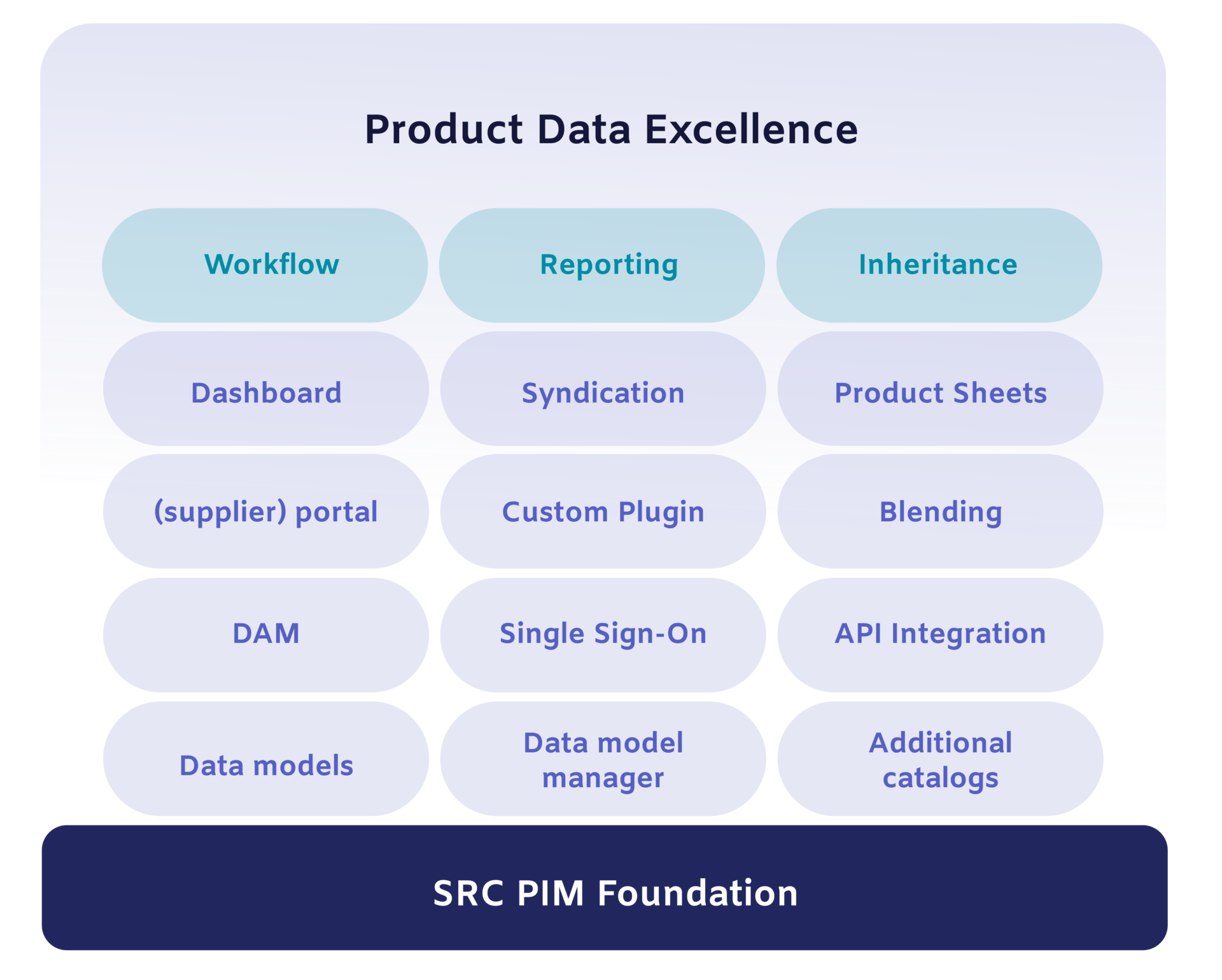What is PIM
PIM stands for Product Information Management. Nowadays, product information contains more than just the logistics data and a concise product description. Consumers expect comprehensive and relevant information to make a purchase decision. With a PIM system you bring all product information together, enrich it with additional information and efficiently publish relevant product information to all channels.
1. What is a PIM system?
A product information management (PIM) system is an online tool or software that makes it possible to manage product information from one place.
A PIM system is integrated with other systems of an organization, such as the ERP system, and connects these systems with the channels that disseminate the product information in the market: often websites. This creates a “single-source-of-truth” — a central point where all product information is stored and from which you know that the data is up-to-date and reliable.

What is PIM?
PIM is the abbreviation for Product Information Management. A PIM system is an online tool or software that is integrated into the other systems of your organization. All systems that provide product information, for example the ERP system, are connected by a PIM to the channels that disseminate product information in the market, for example the webshop. A PIM system is therefore also called a single-source-of-truth – all product information comes together in the PIM system, of which you can be sure that it is up-to-date and is reliable.
The concept of a PIM system is that all product information is processed and stored once. The primary task of a PIM system is to make large amounts of complex information manageable. The most important functionalities of a PIM system are therefore the processing, enrichment and publication of product information.

What data does a PIM system record? In addition to commercial product specifications, a PIM system also records logistical data, compliance data and digital assets . Think of the dimensions of the packaging, ingredients and prices to product images and product descriptions.
For whom is PIM interesting?
The choice for a PIM system depends on the type of organization and the amount of data that needs to be processed. Most organizations use a PIM system when the demand for relevant product information increases and this can no longer be processed manually or with the current systems (often also Excel).
In addition, the requirements imposed on product information are becoming increasingly complex. This includes legislation and regulations, customer requirements or compliance with specific data standards such as GS1. When data is processed manually or spread across different databases, finding the right information and publishing it to the different sales channels is a challenge.
Within an organization, different people and departments work with product information. A PIM system therefore affects different departments within an organization:
Logistics
A PIM system is used to manage stocks and share logistics data such as product dimensions.
Marketing/ecommerce and sales
Product information is used to help consumers make an informed choice or provide a better experience. Think of naming the price, features and showing product images or videos.
Because the implementation of a PIM system requires an investment, a PIM system is profitable for companies that:
- Having to deal with a regularly changing product file. If this is the case, you cannot make all changes without a PIM system.
- Manage multiple channels that process product information. Channels such as a website, ERP system or POS channel must be continuously provided with the correct product information.
- Working with data standards such as GS1. Companies have to deal with market standards. With a PIM system you provide structured product information according to the applicable market standard.
Download eBook
Stop manually processing product information and stay in control at all stages of product management.

2. Why use a PIM system?
A PIM system is used when the amount of product information can no longer be processed manually. Because you work from one system, you have more control over your product data and you are no longer dependent on multiple systems. When product information is managed in a PIM system, you are assured that all data is the same everywhere. This ensures better data quality because there are no differences between them.
In addition, a PIM system optimizes internal processes by simplifying collaboration between departments. Departments work together on data in the PIM system. Because this is done in parallel, they do not have to mail Excel spreadsheets and they get all the necessary information directly from the PIM system.

Why should you use a PIM system?
At companies, product information is often distributed throughout the organization and stored in different systems. Publishing data to suppliers and relevant channels is therefore unnecessarily time-consuming and prone to errors. To efficiently manage product information, a PIM system has become indispensable.
Improving internal processes
The biggest advantage of a PIM system is that it improves and optimizes internal processes. Internal departments are no longer dependent on each other. All necessary information can be retrieved directly from the PIM system.
It depends on the size and type of organization how many people manage and process product information on a daily basis. In any case, it is important to properly streamline the process of data processing within an organization. You facilitate this by making departments or persons owners of specific data in a PIM system. Most PIM systems have a workflow functionality for this. This leads to more transparency in the organization because it is clear to everyone who is responsible for the data, which data is missing and what is needed to make data complete. This prevents data from being exchanged by email and with Excel.
With the increase in online sales, companies want to provide multiple channels with relevant information in order to meet consumer expectations. A PIM system feeds multiple source systems with the correct product information. This allows you to quickly and efficiently provide all channels with product information.
Better data quality
Good data quality means that your product information is up-to-date, reliable and consistent. A PIM system ensures that all product information is up-to-date and complete by synchronizing with other systems. This ensures that product information is the same on all channels – any inconsistencies between different types of data no longer occur. This also reduces complexity because it makes data more manageable.
Better data quality also means higher revenue. Due to the growth of e-commerce, the need for relevant product information is increasing and product information must comply with legislation and regulations. Think, for example, of naming ingredients, allergens and nutritional values. Consumers search for information online before making a purchase decision. The richer the information you offer, the greater the chance that the consumer will make a purchase from you.
Process data more efficiently
The use of a PIM system ensures that you can process and publish data to customers more efficiently because you no longer have to process product information manually – this prevents errors and is less time-consuming. Errors in product information have consequences for the entire organization. For example, displaying the wrong price, creating the wrong expectations among consumers due to an incorrect product description or incorrect dimensions that lead to problems with packaging, transport and the shelves in the stores.
In addition, a PIM system significantly reduces the time-to-market of your products. Departments no longer have to wait for each other with regard to supplying product information, because data is extracted directly from the PIM system. This ensures that you switch faster and make product information available for sale more quickly.
Download eBook
Stop manually processing product information and stay in control at all stages of product management.

3. Publish to GS1 and other data pools
Worldwide there is one data standard for product information management: Global Data Synchronization (GDS). The worldwide standard is published by GS1.
In the Netherlands, the food and drugstore, DIY, garden-and-animal, healthcare and fashion sectors use the GS1 data standard. Each sector has made agreements about which product information will be exchanged and how the recording should take place.

What is GS1
GS1 stands for Global Standard and is an independent, non-profit organization that develops and manages national and international standards for the identification and recording of data. National departments, such as GS1 Netherlands, determine which part of this global standard applies to a country and industry. This is always coordinated in consultation with suppliers and retailers within the various branches of the country and always based on GDSN.
Product data is recorded in a standardized manner via a GS1 data pool. The advantage of working with the GS1 data standard is that companies speak ‘one language’ among themselves. As a result, there is no need for mutual coordination about how data should be supplied and there is certainty that product information can be used properly by all parties.
This has major advantages for internal business operations and offers consumers more certainty about the reliability of the product information provided.
The use of GS1 is not required by law for companies. In certain industries, however, the use of GS1 is enforced by the customers. Large customers such as Superunie, Albert Heijn (Ahold) and Intergamma prefer to work with suppliers who use GS1. In this sense, GS1 is therefore more or less mandatory for suppliers who want to supply these retailers.
How do you publish data to GS1?
Publishing data to GS1 can be done manually via a web interface of GS1 or via a PIM system. When you use a GS1 web interface, you log in via your browser and then manually fill in all required fields in the portal and publish them to your customers. The disadvantage of this method is that it is not possible to store additional data. You can only publish data for the attributes that are agreed by default. For this reason and because the process is manual via GS1 web interfaces, many companies use a PIM system. However, SRC-PIM is the only PIM system in the Netherlands that has full integration with GS1:
- in SRC-PIM you have real-time insight into whether your product information meets the GS1 standards.
- SRC-PIM supports and maintains the global GS1 standard and its subsets for the food and drugstore, DIY, and healthcare sectors (this is made available as a data model in SRC-PIM).
- from SRC-PIM, product information is published directly to the GS1 data pool.
Other data pools
Organizations increasingly know and recognize the strategic importance of good quality product information. Data standards make the exchange of product data efficient and provide scope for further enrichment. In addition to the GS1 data standard, there are other data pools that are used:
PS Infoodservice
PS Infoodservice is a data standard that is used for food, drink and non-food. Product information is available to wholesalers and customers in the hospitality, healthcare, catering and retail sectors. Product information that is required by allergen legislation is also present in this data pool.
ETIM
This standard is used in the construction, installation and maritime sectors, including manufacturers, wholesalers and installers. ETIM is the model in which products are unambiguously classified into product classes and are provided with characteristics and characteristic values.
Superunie adam
To give everyone working within the Superunie chain insight into the correct product information, Superunie has developed ‘adam’. Adam is an online data pool where all product information comes together.
Download whitepaper
Curious how SRC-PIM works with GS1? Download the whitepaper and discover the benefits of SRC-PIM.

4. How does a PIM system work?
In a PIM system, all information is managed centrally. Processing, enriching or publishing product information only needs to be done in one place. One of the strengths of a PIM system is that it exchanges data with other target systems, including different data pools. For example, SRC-PIM has a direct integration with the GS1 data pools. Thanks to the built-in GS1 data models and validation functionality, you have real-time insight into whether your data meets the requirements set by GS1. A PIM system ensures that you process, enrich and publish your product information quickly and efficiently. With a PIM system you have full control over your product data and you are no longer dependent on other sources.

Integration with other systems
A PIM system occupies a central place within the IT landscape. Product information is collected from various sources. On the one hand you have systems that feed the PIM system with data, on the other hand you have the systems to which the PIM system publishes data. The main systems that integrate with a PIM system are:
- ERP system: almost every production company, wholesaler or retailer has an ERP system to manage logistical or financial processes within the organization. ERP systems are often the most important source with regard to stock and price and the PIM system feeds the ERP with the necessary product data. Some organizations manage product data in the ERP system, but this often turns out to be untenable. Unlike a PIM system, an ERP cannot keep track of the multiple requested (commercial) product data.
- print: despite the strong growth of e-commerce, product catalogs are still widely used. Product images and descriptions are especially important for this channel. Product catalogs are compiled in a software package such as Magento – the PIM system automatically feeds Magento with the product information that can be used to build the catalog.
- warehouse management systems: product data from the PIM system provide the necessary logistics data (for example dimensions) that are relevant for the WMS system. In a fully automated setup, physical products are photographed with a 3D scanner. The data (images and dimensions) are then stored in the PIM system and transferred to the WMS system. There is virtually no manual work involved and all systems are filled with relevant data.
- data pools such as GS1: data pools are used to distribute product information in a standardized way. With a PIM system it is possible to process data according to the relevant standard. By publishing this data to a data pool, you make your product information available to customers.
- e-commerce: a PIM system is often part of an e-commerce project. A PIM system makes it easy to provide the online world (website, webshop, buyer portal) with product information. Good product information means that consumers can quickly find their way in a webshop or website and make the right choices.
Functionalities of a PIM system
PIM systems basically have three functions with regard to product information management: collecting, enriching and publishing.
Collect data: in a PIM system it is possible to collect and manage all your data. A PIM system imports product information from various sources: from a manual import, Excel import to an automated interface with other systems.
Data enrichment: when product information is imported into a PIM system, further data enrichment usually takes place. This includes adding images and SEO texts, classifying products and adding translations. This is also the moment in which data validation ensures that data fields are correctly filled in according to the desired standard.

Within SRC-PIM, GDSN and specific GS1 validations are available in the data models. As a result, product information can be validated in real-time directly in the PIM system – so you have a direct view of the data compliancy with a standard.
Publication of data: It is also only possible for users of SRC-PIM to publish product information to a GS1 data pool when product information is validated and correct. In addition to publication to data pools, there are of course several sources to which publications can be made, such as the e-commerce channel or ERP system.
Download whitepaper
Curious how SRC-PIM works with GS1? Download the whitepaper and discover the benefits of SRC-PIM.

5. Choose the right PIM system for your situation
The process of selecting a PIM system for your organization is the same as for other business software. Nevertheless, it takes time and effort to make the right choice. PIM systems are complex and affect business operations.
To choose the right PIM system for your organization, we present five steps to go through. When your organization needs a PIM system, the next step is to find a solution that best suits your organization and situation.

What to look for when choosing a PIM system
There are several factors that are important when choosing a PIM system. When you are looking for a PIM system, it is important to take the following points into account.
- Functionalities: think in advance what you want to achieve with a PIM system and what important functionalities are that a PIM must contain.
- Supplier flexibility and resources: When looking for a PIM system, there are several suppliers to choose from. Because a PIM system is a complex product that affects your entire business operations, it is important to choose a supplier who is able and willing to respond to your wishes and requirements.
- Scalability: if you are going to process more product information or link more channels to your PIM system, you ideally want a PIM system that is flexible and expandable. Therefore, pay attention to possible scalability when choosing a PIM.
- Safeguarding data quality: the quality of data is extremely important. Some PIM systems have data validation or data quality reports. SRC-PIM is the only PIM system in the Netherlands that has real-time validations based on various standards. Data can only be published to data pools or external channels when data meets the requirements.
- GS1: Because GS1 is the most commonly used data standard in the Netherlands, it is advisable to select a solution that is GS1 compliant. In the Netherlands, the food and drugstore, do-it-yourself, garden-and-animal, healthcare and fashion sectors use the GS1 data standard. Although the use of GS1 is not mandatory, there is a good chance that you will have to process your product information according to the GS1 standard and publish it to a GS1 data pool when you exchange data with companies in these sectors. In some cases, large retailers may not do business with suppliers who do not process product information according to the GS1 data standard.
How do you determine which PIM system suits your organization?
Choosing a PIM system is not easy. The step-by-step plan below will help you make the right choice for your organization.
Step 1: assemble a team
A PIM system affects the entire organization. Therefore, involve a team with all stakeholders in the selection process. Make sure that the IT department is involved at least for the technical knowledge.
Step 2: make a MoSCoW list before talking to suppliers
Before entering into discussions with suppliers of PIM systems, draw up a list of requirements that a PIM system must meet. The best way to compile such a list is through the MoSCoW method: Must have, Should have, Could have and Would have.
If a ‘Must have’ on your list cannot be realized by a PIM system, this solution is not an option for your organization.
Step 3: Look beyond technical and functional properties
There are several suppliers who supply a PIM system. Technical and functional properties are of course important, but you can also take other factors into account in the selection process. Questions you can ask, for example: What is the reputation of the supplier? Does the PIM system have good references? What is the pricing model?
Step 4: Make a shortlist and schedule a demo
Compile a shortlist of PIM systems based on your MoSCoW list. Limit yourself to a maximum of five suppliers. Try to schedule a demo with these suppliers. When you send a questionnaire in which suppliers have to indicate whether their PIM system supports certain functionalities, there is a good chance that most suppliers will respond positively. A demo not only gives you more insight into the PIM system. You can immediately see whether certain functionalities are present and what the ease of use is. During a demo, don’t focus on the user interface, but above all test the operation and ask questions about the functionalities you want.
Step 5: Create a ranking
All team members must score all suppliers/PIM systems for the criteria you determined in steps 2 and 3. Keep this simple – give the worst scoring supplier a ‘1’ and the best a ‘3’. Filter suppliers from your list that cannot deliver a must have.
6. How do you integrate a PIM system?
When you have found a PIM system, the next step is to implement it in your organization. For this you have to take into account the existing processes and governance regarding data management.
Although the implementation of a PIM system is largely the same as other software solutions, integrating a PIM system is sometimes a difficult process. This is because the integration of a PIM system goes beyond just a technical implementation – a PIM system changes the way data management takes place within the organization.

How do you integrate a PIM into your other systems?
A PIM system exchanges product information with other systems. This can be done by means of XML links, APIs or in some cases the import from an Excel file. It is important to know that there are no real standard links. A link must always be configured on your existing systems and wishes/requirements.
Synchronization with GS1
There are various PIM systems that make it possible to process data according to the GS1 standard. However, SRC-PIM is the only solution that is fully integrated with the GS1 data pools.
The direct integration makes it possible to process and enrich product information in SRC-PIM and to publish it directly to the GS1 data pool. Customers (retailers such as Albert Heijn and chains affiliated with Superunie) then use SRC-PIM to directly receive product information from their suppliers. Because GDSN and specific GS1 validations are available directly in the data models of SRC-PIM, product information real-time is validated in the PIM system.
The validations in SRC-PIM are clearly visible to the user. Validations are prominently displayed and indicate exactly what you need to adjust.
The GS1 standard for the food, do-it-yourself and healthcare sectors in the Benelux requires the use of product images. In addition to the integration with GS1, SRC-PIM has an integrated Digital Asset Management module (DAM) that makes it possible to manage and publish product images to the desired systems.
SRC-PIM is the only solution that is fully integrated with the GS1 data pools.
Paul Laan (Product Owner – SRC)
How to integrate a PIM system into the organization
Integrating a PIM system can be a complicated process. In addition to the technical implementation, you also need to restructure your internal processes. An integration partner can support and advise you during the implementation process.
Do you want to implement a PIM system yourself? Then follow the steps below:
- 1. Draw up an action plan: determine a vision and strategy for your PIM system. What is your target? Where is data now stored? What is the desired situation?
- 2. Align processes and organization: determine which product information is required and which teams are involved. For optimal functioning of a PIM system, it is important that all teams are aligned.
- 3. Set up the system: in addition to the technical set-up and determination of the (custom) data model, you determine, among other things, what the workflow of data processing looks like.
- 4. Import your product information: transfer all existing product information to the PIM system. You can do this manually or automatically.
- 5. Test before going live: do multiple tests before publishing data to suppliers or data pools. Make sure synchronizations work and set up instructions for users of the system.
- 6. Go live: collect, process, enrich and publish data to your channels. Do you work with data standards? Make sure that data is validated and preferably your suppliers also comply with the data standard.
To guarantee the continuity of the PIM system, you need a team that is responsible for the PIM system. Make sure this team has knowledge of your products and associated data. Most PIM systems allow you to create workflows and make specific people responsible for processing product information.
7. Our solutions
Our PIM system has been around for over twenty years and a large number of customers, from Coca Cola to Intergamma, rely on our proven technology.
With our Product Information Management (PIM) SaaS solution you are in control of all phases of product management: collecting, enriching and publishing.
The core of SRC-PIM is integrated with the regulations and standards regarding data standards, such as GDSN, GS1-DHZ, GS1-Food, GS1-Healthcare and PS in foodservice. A standard connection to these standards is included and the data model is constantly maintained by us.

Manage all your product information centrally and publish quickly and efficiently to the GS1 data pools. Request a demo here and get a complete picture of what SRC-PIM application can mean for your organization.
What is a PIM system?
A Product Information Management (PIM) system is an online tool or software that consolidates and manages product information from various systems within an organization. It serves as a single-source-of-truth, ensuring that all product information is up-to-date, reliable, and consistent across all channels.
Why should organizations use a PIM system?
Organizations should use a PIM system to streamline their internal processes, improve data quality, and process data more efficiently. By centralizing product information, PIM systems enhance collaboration between departments, reduce errors, and decrease the time-to-market for products. This ultimately leads to better customer experiences and higher revenues.